Report

This article is part of Bain’s 2019 Global Private Equity Report. This section looks at how a growing number of GPs are facing down rising deal multiples by using buy-and-build strategies as a form of multiple arbitrage. Explore the contents of the report here or download the PDF to read the full report.
When Investcorp acquired Chicago’s Berlin Packaging for around $410 million in 2007, it was already a strong player in the container business. Yet seven years and four strategic acquisitions later, Investcorp sold out to Oak Hill Capital Partners for $1.43 billion, creating a better than three times return. Since then, Oak Hill and Andrew Berlin, the company’s well-regarded CEO, have doubled down on the buy-and-build strategy with four more major acquisitions and a scattering of smaller ones. In November 2018, they attracted $500 million in new capital from the Canada Pension Plan Investment Board. The objective: more acquisitions in North America and Europe.
While buy-and-build strategies like this one have been around as long as private equity has, they’ve never been as popular as they are right now. The reason is simple: Buy-and-build can offer a clear path to value at a time when deal multiples are at record levels and GPs are under heavy pressure to find strategies that don’t rely on traditional tailwinds like falling interest rates and stable GDP growth. Buying a strong platform company like Berlin Packaging and building value rapidly through well-executed add-ons can generate impressive returns. As the strategy becomes more and more popular, however, GPs are discovering that doing it well is not as easy as it looks.
When we talk about buy-and-build, we don’t mean portfolio companies that pick up one or two acquisitions over the course of a holding period. We also aren’t referring to onetime mergers meant to build scale or scope in a single stroke. We define buy-and-build as an explicit strategy for building value by using a well-positioned platform company to make at least four sequential add-on acquisitions of smaller companies. Measuring this activity with the data available isn’t easy. But you can get a sense of its growth by looking at add-on transactions. In 2003, just 21% of all add-on deals represented at least the fourth acquisition by a single platform company. That number is closer to 30% in recent years, and in 10% of the cases, the add-on was at least the 10th sequential acquisition (see Figure 2.1).
Around 30% of the time, add-on transactions are part of a broader buy-and-build strategy

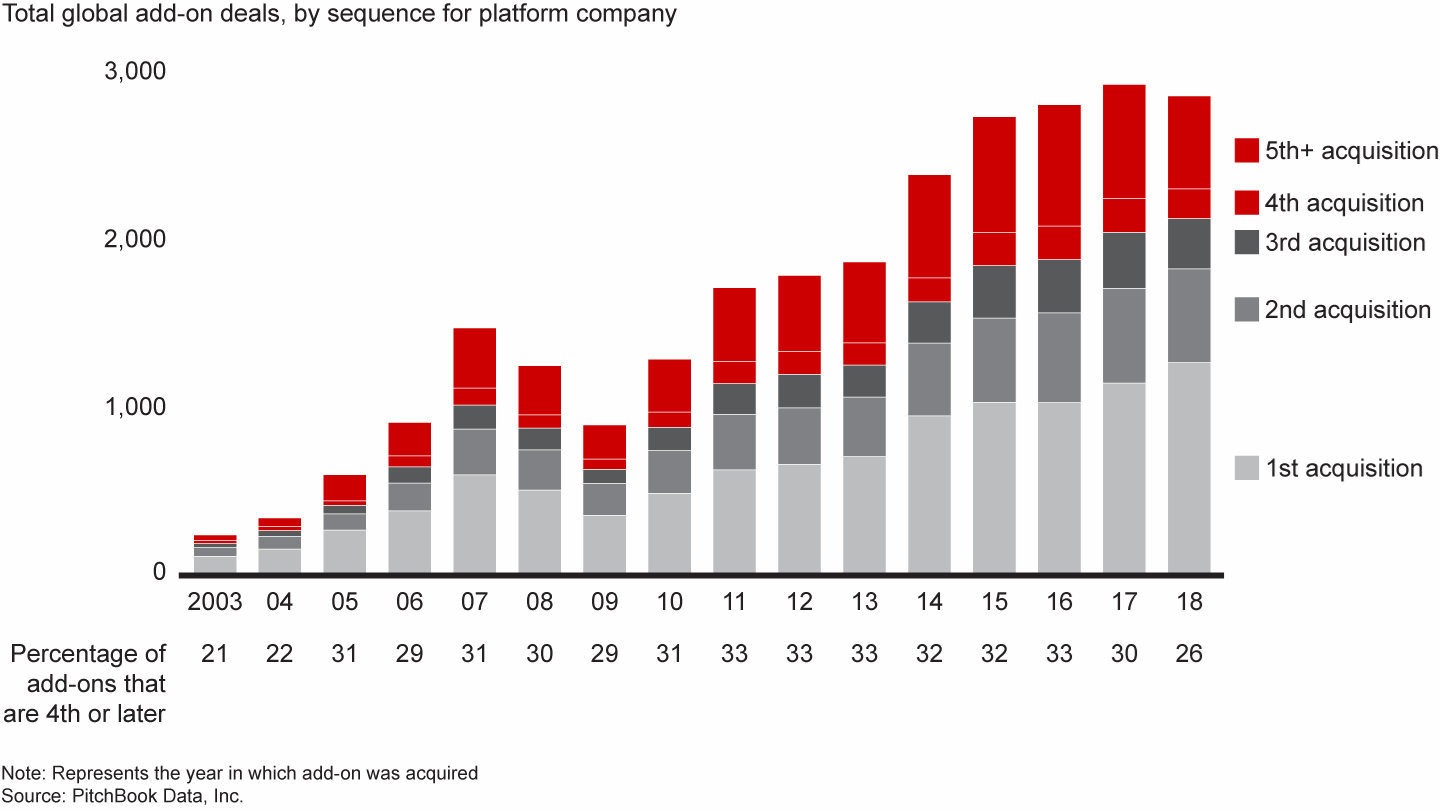
Buy-and-build strategies are showing up across a wide swath of industries (see Figure 2.2). They are also moving out of the small- to middle-market range as larger firms target larger platform companies (see Figure 2.3). KKR is a good example. It has been pursuing a buy-and-build strategy in the cybersecurity business through Optiv, a Denver-based company with $2.25 billion in revenue. In early 2018, Optiv hired a European general manager with extensive rollup experience in the security industry and began pursuing acquisitions of independent security firms in Britain and Europe.
Platform companies pursuing buy-and-build strategies have become common across sectors

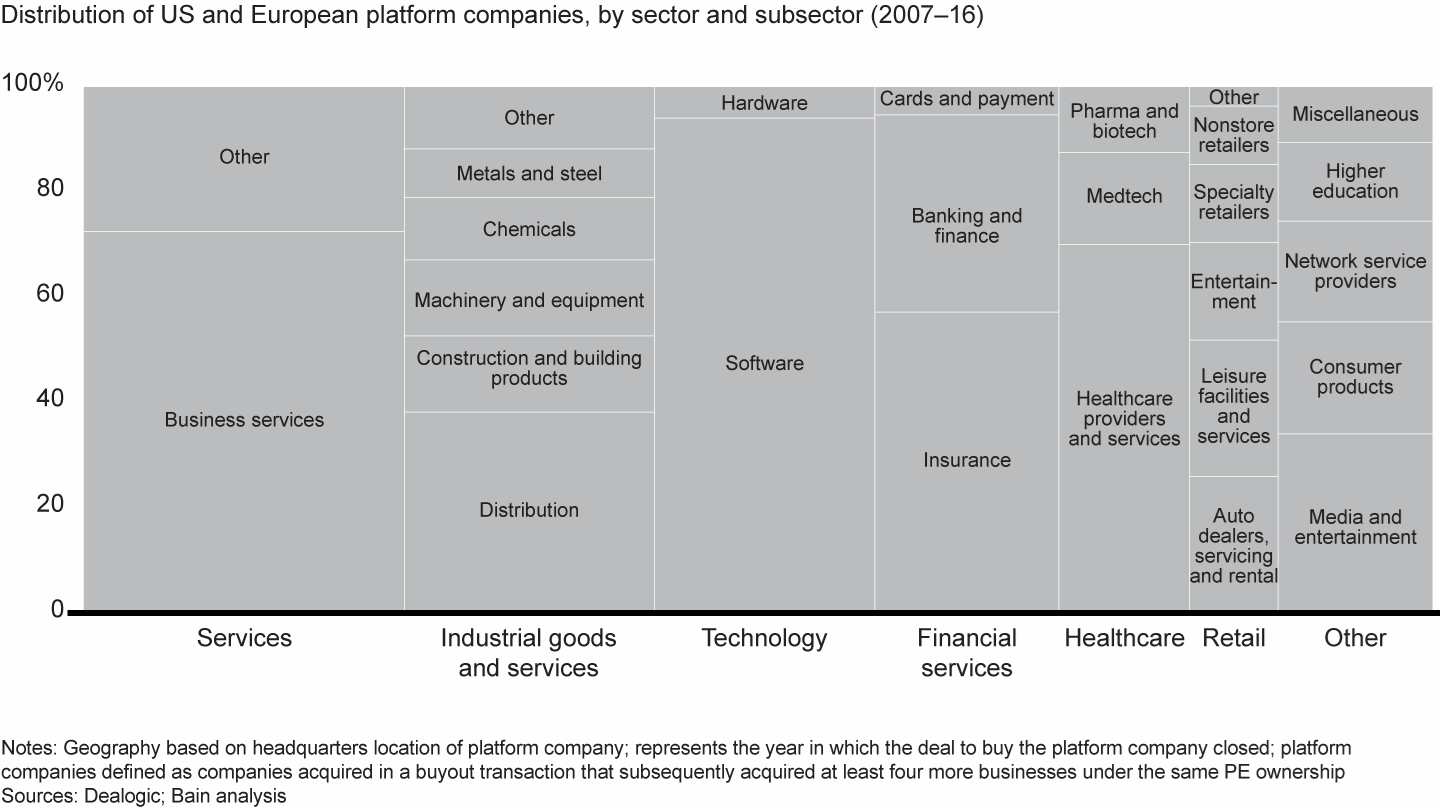
Platform companies are also getting bigger as larger firms enter the fray

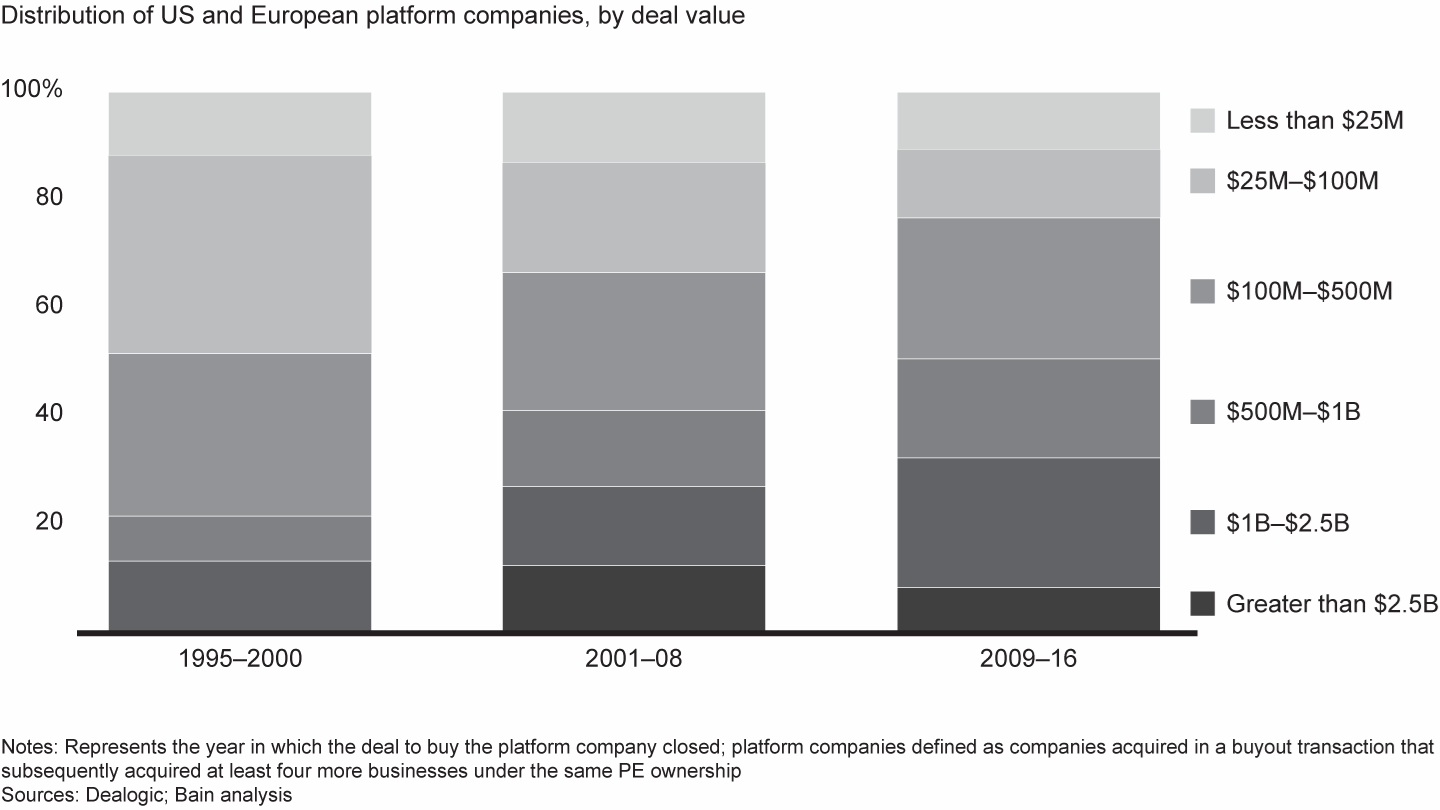
Buy-and-build strategies are popular because they offer a powerful antidote to soaring deal multiples. They give GPs a way to take advantage of the market’s tendency to assign big companies higher valuations than smaller ones (see Figure 2.4). A buy-and-build strategy allows a GP to justify the initial acquisition of a relatively expensive platform company by offering the opportunity to tuck in smaller add-ons that can be acquired for lower multiples later on. This multiple arbitrage brings down the firm’s average cost of acquisition, while putting capital to work and building additional asset value through scale and scope. At the same time, serial acquisitions allow GPs to build value through synergies that reduce costs or add to the top line. The objective is to assemble a powerful new business such that the whole is worth significantly more than the parts.
Smaller companies consistently trade for lower multiples than bigger ones, offering an opportunity for multiple arbitrage

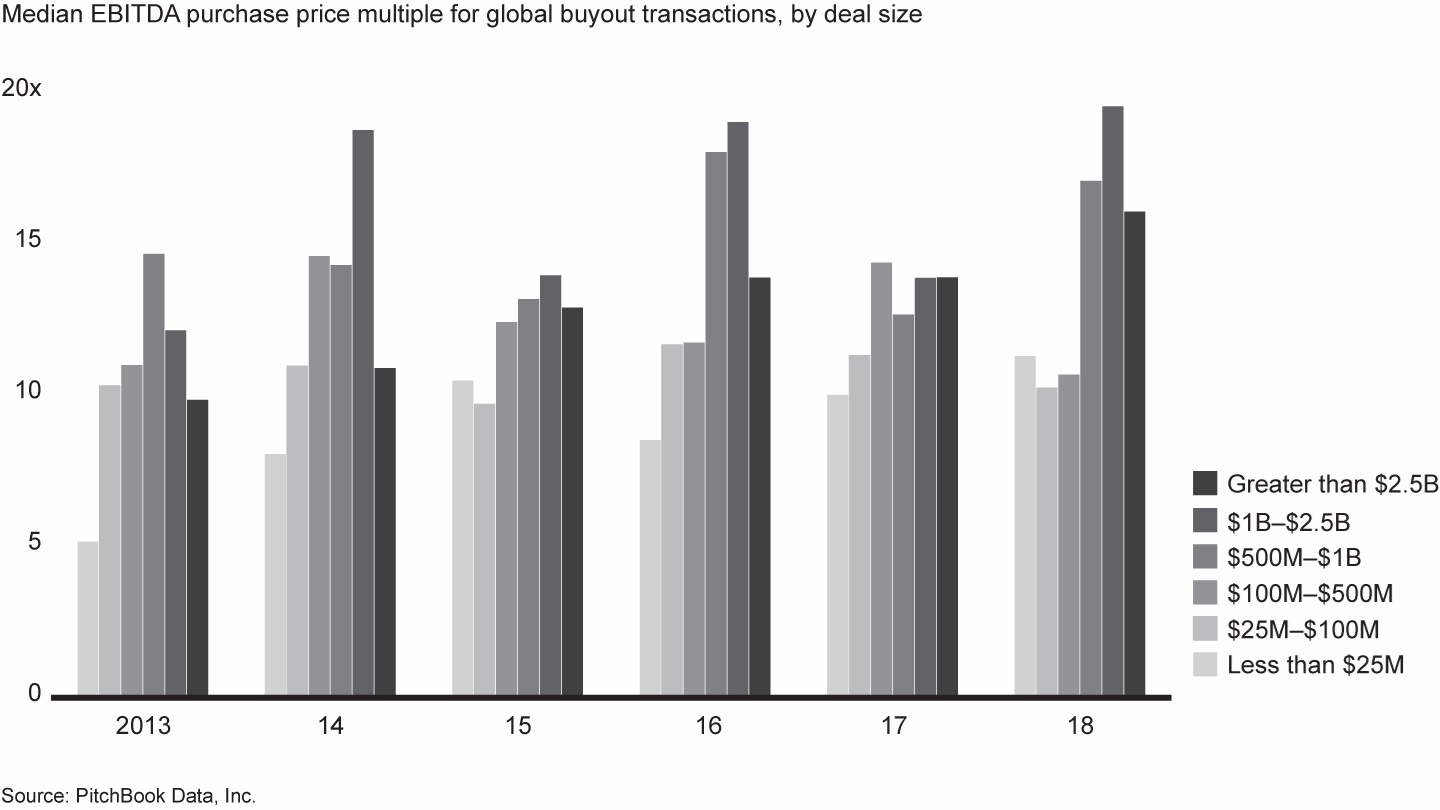
Having coinvested in or advised on hundreds of buy-and-build deals over the past 20 years, we’ve learned that sponsors tend to underestimate what it takes to win. We’ve seen buy-and-build strategies offer firms a number of compelling paths to value creation, but we’ve also seen these approaches badly underperform other strategies. Every deal is different, of course, but there are patterns to success. The most effective buy-and-build strategies share several important characteristics.
A sector with room to run
Sector dynamics can have a huge impact on the success or failure of a given buy-and-build strategy. Value creation depends on a steady cadence of acquisitions, which means a sector has to provide an ample supply of targets and a stable environment in which to pursue them. Importantly, the platform company usually makes the add-on acquisitions—not the PE fund—so it’s critical that the company generates consistent free cash flow to finance deals in succession.
Sector issues can disrupt cash flow in a number of ways—cyclicality being the most obvious. In an industry like oil and gas, for instance, ping-ponging demand can wreak havoc on free cash flow, crimping a platform’s ability to do deals. The potential for large-scale technological disruption is another factor. Buy-and-build was a brilliant strategy in the magazine business until the Internet plundered print advertising and completely changed the industry’s economics. Supplier or customer consolidation can also upset the best-laid plans. Buy-and-build depends in part on creating scale advantages. But if suppliers or customers are combining in parallel, a business plan that relies on increased purchasing leverage or pricing power can fall apart quickly.
Following the stability imperative, the most effective buy-and-build strategies target sectors with predictable secular growth and a low risk of disruption (unless, of course, the platform company is the disrupter). They also target fragmented industries with sufficient acquisition targets of the right size. This raises two questions in diligence: First, will potential add-ons have lower valuations than the platform company, so that buying them presents a true multiple-arbitrage opportunity? Second, will potential add-ons be meaningfully accretive? In other words, does the sector offer plenty of targets that are smaller than the platform company, but not so small that acquiring them doesn’t add value?
Plenty of white space
The sector’s “white space” is a function of supply and demand. On the supply side, how many businesses are there in the sector that might naturally transact? Are a lot of founders reaching retirement age, or are macro pressures making it difficult to remain independent? On the demand side, how many other consolidators or strategic buyers are already at work in the industry picking off the ripest fruit, and what are their cumulative plans? These questions add up to a bigger one that guides due diligence: Does the potential for acquisitions in this sector provide enough runway for the buy-and-build strategy to create meaningful value? Too much demand for too few targets will drive up prices and compete away the multiple-arbitrage opportunity.
When Cressey & Company acquired control of VetCor Professional Practices in 2010, the company already had 41 veterinary practices. Yet the industry was growing steadily and remained highly fragmented. The vast majority of practices were independent, and many practice owners were nearing retirement age. These smaller businesses could be acquired for a mid-single-digit EBITDA multiple (vs. a mid-teens multiple for the platform), making for an attractive multiple-arbitrage opportunity. Pet ownership, meanwhile, was on the rise, and veterinary practices generated steady, recession-proof cash flow since owners care for their pets in good times and bad. VetCor could create efficiencies by offering a standardized package of management, training and administrative support. Individual clinics could keep their local identities, and resident veterinarians would remain in control of medical decisions.
Control of VetCor shifted from Cressey to Harvest Partners in 2015 and then to Oak Hill Capital in 2018 (all three firms remain investors). VetCor now has more than 300 practices and adds 2 or 3 each month. With other consolidators jumping into the veterinary sector, it has become critical to understand how quickly the remaining consolidation opportunity is being eaten away. A recent analysis shows that, given the current state of play, the veterinary space still offers plenty of runway for current and future investors to execute on buy-and-build (see Figure 2.5). But dynamics can change quickly as capital and consolidators pile in. For anyone getting in now, a fresh look at the white space will be essential.
A white-space analysis of the US veterinary business indicates plenty of runway for future consolidators

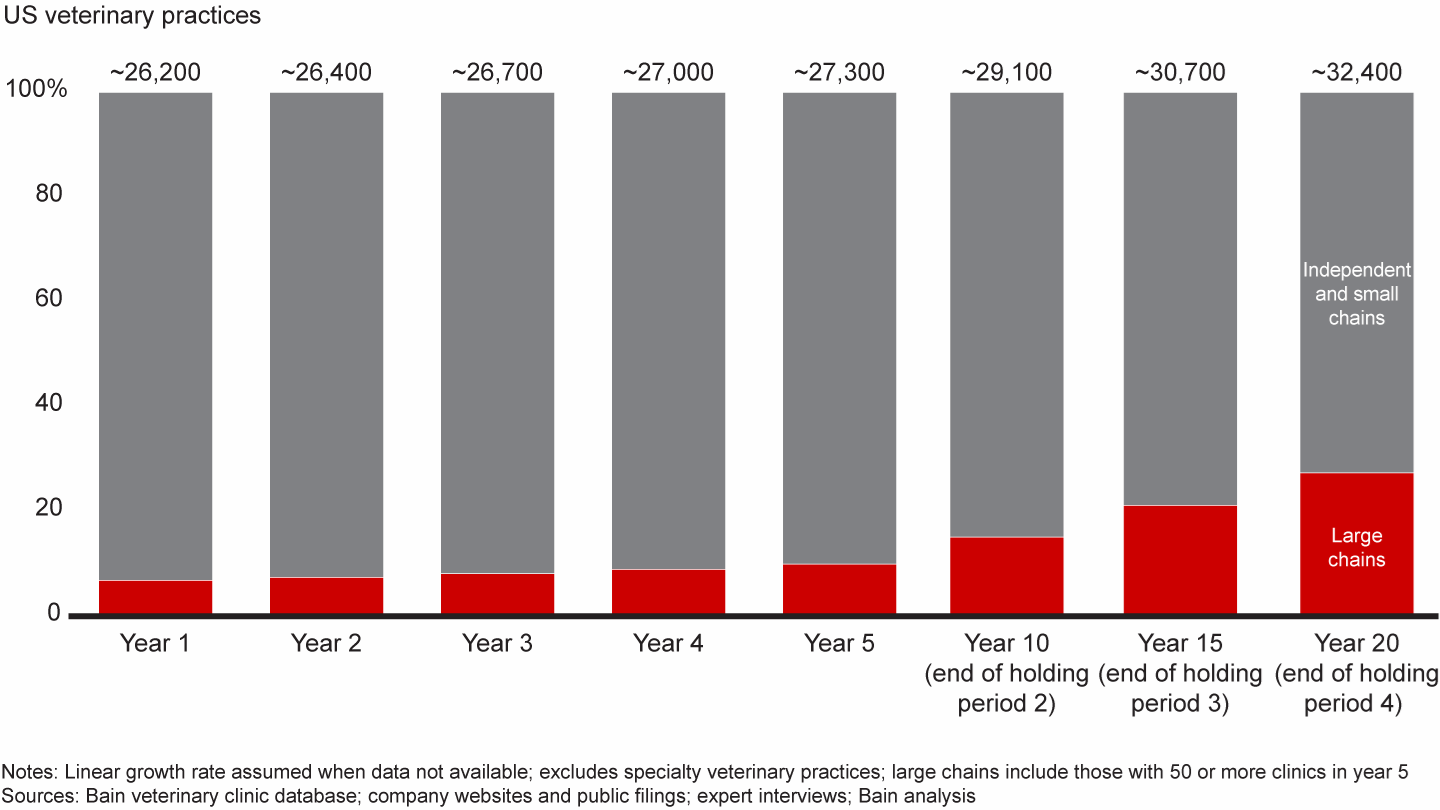
Coming in late or following the herd can spell trouble. A good example is the funeral home industry. As macabre as it sounds, PE-backed buy-and-build strategies thrived in the US death business for years. Eventually, a crowd of consolidators picked off all the attractive midsize targets, bid up asset prices and eroded the multiple-arbitrage opportunity. In essence, the sector had “barbelled,” meaning companies were either too big or too small, with nothing left in the middle to support a buy-and-build strategy.
GPs can avoid getting caught by focusing on their exit strategy from day one. If the sector continues to offer buy-and-build opportunity, it leaves runway for the next buyer to continue the consolidation, which should improve exit value. If buy-and-build is largely exhausted, the exit story needs to reflect a clear shift in strategy. Often the opportunity graduates from buy-and-build to scale M&A, where a consolidator starts buying up other consolidators. Alternatively, the most logical next owner might be a strategic buyer that is looking to expand in the sector and sees value in a newly scaled-up platform company.

Get Our Latest Private Equity Insights
Receive Bain’s landmark Global Private Equity Report each February, plus the latest insights and developments in private equity throughout the year.
Building on a solid platform
As we noted earlier, the most effective buy-and-build strategies assume that the platform company’s free cash flow will fuel acquisitions. The PE fund is theoretically a backstop if the platform asset starts to sputter, but few GPs are willing to throw good money after bad if the well runs dry at the platform level. It’s also critical to determine if the platform is stable enough to support what the fund wants to do with it. To pursue an efficient acquisition strategy, the buyer needs the right foundational infrastructure—robust IT systems, a strong balance sheet, repeatable financial and operational models, and assets like distribution and sales networks that are set up for expansion.
It’s an enormous benefit to start with a strong existing management team that has already demonstrated its ability to pull off acquisitions. That’s what Investcorp saw in Andrew Berlin, who, at 27, joined the 1988 leveraged buyout of the former Alco packaging company in Chicago. Through acquisitions, Berlin Packaging grew into an industry leader with a history of strong margins and free cash flow. Its innovation and design capabilities were top notch, and it developed a loyal customer base. Andrew Berlin expanded the business at double the market rate and quickly integrated newly bought companies. The CEO was—and still is, under new owner Oak Hill—integral to implementing the growth strategy.
It’s not always that easy. When Advent International took over Morrison Supply Company in 2011, the distributor of HVAC, plumbing and oil pipeline–related products was still recovering from the global financial crisis. Advent saw a clear opportunity to buy and build within the sector, but it knew that Morrison would need some shoring up first. Advent brought in a CEO with 20 years of experience in the building supply industry, and he recruited a new executive team. The CEO rebranded the company as MORSCO and set it up as a holding company that could easily absorb newly acquired distributors. MORSCO opened a 128,000-square-foot shared distribution center, rationalized the supply chain by switching to a vendor-managed inventory system, and revamped back-office operations to centralize many aspects of purchasing and operations. The new, more efficient holding company structure accelerated the M&A cadence and transformed MORSCO into one of the fastest-growing companies in the industry. After six large acquisitions and a slew of smaller tuck-ins, in 2018 Advent sold the company for $1.44 billion to an enthusiastic corporate buyer, Reece Group. A leading Australian distributor of plumbing, waterworks and HVAC products, Reece sees MORSCO as its ticket to expand in a US market that is growing twice as fast as Australia’s.
A central question in diligence is how much work the platform company needs in order to spearhead the strategy. If the answer is a lot, it can drastically affect the timing of value creation. PE firms are often buying someone else’s starting point. The company might already have made acquisitions that are poorly integrated. IT systems may look like spaghetti, go-to-market strategies may be at odds, one unit’s delivery trucks might be driving past another’s distribution centers. Fixing issues like these takes both time and investment, which may pay off if the opportunity is big enough. The key, however, is going in with eyes wide open as to what the up-front costs really are. A years-long reclamation process can cut deeply into ROI.
Targets that add value
While vetting the right targets for buy-and-build involves all the normal M&A diligence questions, the key factors are strategic: How does an add-on or group of add-ons increase value? More is not simply better; an acquisition has to fit into a strategic logic that assumes the whole is worth more than the sum of its parts.
For this reason, successful buy-and-build strategies target acquisitions that are close to the core, rolling up a set of highly related companies to achieve the benefits of scale. VetCor, for instance, is a classic like-meets-like rollup, where the value comes from taking advantage of synergies and increasing market power. Moving into adjacencies can make sense, but it is critical to understand the risk. The further a company strays from its core, the greater the chance that something goes wrong.
Bain defines a company’s core as the clients, products and services that a) drive the majority of its profits and profitable growth, and b) provide its key competitive advantage. Defining a company’s core is the heart of strategic planning and an essential element in ensuring that each acquisition adds value to the platform. Each step away from the core creates distance between the acquisition and what the company does best. The question becomes, how much overlap is there between the two companies’ customers, costs, channels, capabilities and competition? A rollup strategy assumes significant, if not total, overlap. Close-in adjacencies have less overlap, and two-step adjacencies have significant differences. Looking at potential acquisitions—or the entire strategy—through this lens prevents firms from trying to knit together related businesses that are further from the core than they seem.
A company’s core and adjacencies aren’t always obvious. Ascend Learning, for instance, looks like a hodgepodge of training businesses and brands. In fact, since it was acquired by Providence Equity Partners in 2007, the company has grown into a global leader in online learning. Providence sold a partial stake to the Ontario Teachers’ Pension Plan in 2014, and after more than a dozen acquisitions, they sold Ascend in 2017 to Blackstone and the Canada Pension Plan Investment Board for over $2 billion. Its acquisition strategy pushed Ascend into a diverse array of industries with vastly different training and certification needs—physician, nurse and EMT training; construction safety training; fitness professional training; insurance training; auto mechanic training; etc. In defining its core, however, Ascend wasn’t focused so much on what its businesses were teaching or who the students were. The glue holding everything together was the company’s ability to combine content, assessment analytics and software, using shared platforms. That amounts to an asset that can be used for, and adapted to, different industries, tests and customer needs, allowing the company to reliably accelerate the growth of nascent e-learning businesses, while quickly monetizing new product development and distribution partnerships. By looking at the e-learning industry through a nontraditional lens, Ascend has been able to build tremendous value.
The same can’t be said for Aurora Foods. An early example of a PE-driven buy-and-build strategy, Aurora started buying up “orphaned” premium brands like Mrs. Butterworth’s and Log Cabin syrups in 1996 under the ownership of Dartford Partnership, Fenway Partners and McCown De Leeuw. Two years later, the company bought budget brand Duncan Hines and merged with Van de Kamp’s, which specialized in frozen foods—seafood, pizza and breakfast foods. The combined company went public in 1999 but ultimately filed for bankruptcy in 2003. A major problem: Aurora had strayed too far from its core and wasn’t able to create value out of its combination of assets. From the outside, each of its acquisitions said “food,” but it turned out that premium foods on shelves and budget foods in the freezer aisles are actually very different businesses, with little overlap in terms of costs and capabilities. What looked like a chance to create scope and take advantage of synergies never materialized as Aurora had hoped.
The buy-and-build strategies that outperform typically rely on multiple paths to value creation. They take full advantage of multiple arbitrage, they identify and capture synergies and operational improvements, and they generate top-line growth by improving commercial capabilities and implementing smarter go-to-market strategies at each company acquired. Spotting these opportunities has to be the explicit target of due diligence, so that the fund can begin pulling each of these levers from day one of ownership. Interface Security Systems, for instance, looked like a straight-ahead rollup play. SunTx Capital Partners bought it in 2001 and has since recapitalized several times to fund more than 10 acquisitions in the security space. Each add-on offered the usual opportunities to capture synergies by consolidating branches and reducing overhead in the back office. But SunTx has also used each one to build a more valuable whole. Instead of a collection of standalone monitored security services, Interface offers a bundle of cloud-based services for companies tired of purchasing them individually and having to integrate them on premise. The company’s tagline—“simplify to the power of one”—describes this value proposition, but it might just as well be applied to the logic of SunTx’s long-term buy-and-build strategy.
A winning approach
Too many attempts at creating value through buy-and-build founder on the shoals of bad planning. What looks like a slam-dunk strategy rarely is. Winning involves assessing the dynamics at work in a given sector and using those insights to weave together the right set of assets. The firms that get it right understand three things going in:
- Deep, holistic diligence is critical. In buy-and-build, due diligence doesn’t start with the first acquisition. The most effective practitioners diligence the whole opportunity, not just the component parts. That means understanding how the strategy will create value in a given sector using a specific platform company to acquire a well-defined type of add-on. Are there enough targets in the sector, and is it stable enough to support growth? Does the platform already have the right infrastructure to make acquisitions, or will you need to build those capabilities? Who are the potential targets, and what do they add? Deep answers to questions like these are a necessary prerequisite to evaluating the real potential of a buy-and-build thesis.
- Execution is as important as the investment. Great diligence leads to a great playbook. The best firms have a clear plan for what to buy, how to integrate it, and what roles fund management and platform company leadership will play. This starts with building a leadership team that is fit for purpose. It also means identifying bottlenecks (e.g., IT systems, integration team) and addressing them quickly. There are multiple models that can work—some rely on extensive involvement from deal teams, while others assume strong platform management will take the wheel. But given the PE time frame, the imperative is to have a clear plan up front and to accelerate acquisition activity during what inevitably feels like a very short holding period.
- Pattern recognition counts. Being able to see what works comes with time and experience. Learning, however, relies on a conscious effort to diagnose what worked well (or didn’t) with past deals. This forensic analysis should include the choice of targets, as well as how decisions along each link of the investment value chain (either by fund management or platform company management) created or destroyed value. Outcomes improve only when leaders use insights from past deals to make better choices the next time.
At a time when soaring asset prices are dialing up the need for GPs to create value any way they can, an increasing number of firms are turning to buy-and-build strategies. The potential for value creation is there; capturing it requires sophisticated due diligence, a clear playbook, and strong, experienced leadership.
This article is part of Bain’s 2019 Global Private Equity Report. Explore the contents of the report here or download the PDF to read the full report.